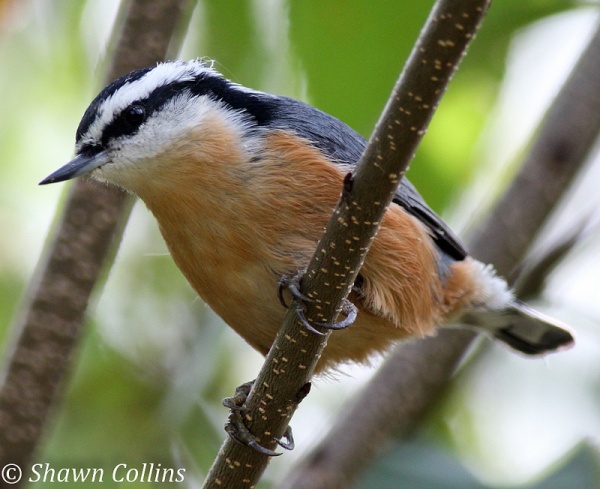
Red-breasted nuthatches are the first bird I hear every morning in Maine. What are they up to?
Right now they’re spending a lot of time caching conifer seeds to last them through the winter. All summer long they ate arboreal arthropods (insects in trees) but now they’re switching to seeds, hiding them under bark or in sapsucker holes, covering the opening with lichen or plant matter. If there aren’t enough cones they move south, as so many did last winter.
Though they depend on cone-bearing trees for food, red-breasted nuthatches prefer to nest in dead or dying birches or aspens whose trunk is softened by disease or rot. They often pick a birch with a broken top. The lady digs the nest hole while her mate watches and brings her food. She throws sawdust out of the hole leaving a telltale pile below the nest. I’ve never seen this because I’m never in Maine during nesting season.
If I came here in the spring — or spent time watching the few red-breasted nuthatches who nest near Pittsburgh — I would see this amazing nesting habit: To protect their eggs and nestlings they collect pine sap on the tips of their bills or on a little piece of bark, then smear it around the opening of the nest. The male smears sap on the outside, the female smears it on the inside. Experiments have shown this sticky mess keeps away both predators and competitors.
Adult nuthatches are very skillful at zooming straight into the nest without touching the sides — those who don’t are eliminated from the gene pool — so how do the nestlings fledge without getting stuck? According to Birds of North America Online, parent nuthatches place small clumps of fur on the sticky inner nest rim on the day of fledging.
They make a stick-free launch zone for the kids to leave the sappy nest.
(photo by Shawn Collins)
Thanks for the interesting info!
Kate–can you write about how the birds seem to ‘congregate’ as fall approaches? There’s a noisy bunch across from my boyfriend’s house & now I am seeing strings of them along the signs on the parkway–sometimes 50+
Beth, I’ll keep your suggestion in mind. Meanwhile, click here for a blog post from 2008 that talks about flocking behavior.